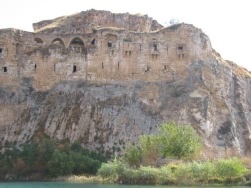“Greek (Rum) Castle”
Old/other names: Hromgla/Sitamrat, Urumgala, Qal’at al-Rum
Right in the middle of nowhere, the dramatic ruins of Rumkale stand high above the blue-green waters of the Euphrates (Fırat) river at Halfeti, accessible only by boat. It is one of Turkey’s most evocative sights. However, access has not been possible for many years as work to restore (i.e. rebuild) the castle and the buildings within it continues.
Backstory
The site is thought to have been settled by the Assyrian king Salamassar III in 885 BC at a time when it stood some 500m above the river.
In 1113 a bishopric was established inside the castle but in the early 13th century the site was captured by the Mamluks of Egypt. Then in 1516 it was seized by Sultan Selim I, whereupon it fell under the control of the Ottoman governor of Aleppo (Haleb).
Around the site
At Halfeti tour boats wait to take visitors up the river to Rumkale. Private tours are also possible but offputtingly expensive. The boats carve their leisurely way through a rocky gorge reminiscent of the better-known Ihlara Valley in Cappadocia but with a great deal more water in it.
Then, on the western bank of the river, you begin to make out the shattered walls of what must once have been a magnificent seven-gated medieval castle built over the site of a church where some believe that St John made a copy of the Bible and hid it until it could be smuggled out to Beirut. Some people even believe that St John died and was buried here although his remains have never been found.
 These days the ruins of the castle stand on a peninsula just 150m above the level of the water. In theory the adventurous can land on the far side and scramble up a treacherous path to explore the remains of some old houses, the 17th-century church of St Nerses, a cistern and a deep well into which the mythological character Narcissus may have tumbled while admiring his own reflection; the less adventurous can settle for a quick lunch at a nearby cafe with a view overlooking the ruins. However, it may be some years before access to the castle is restored.
These days the ruins of the castle stand on a peninsula just 150m above the level of the water. In theory the adventurous can land on the far side and scramble up a treacherous path to explore the remains of some old houses, the 17th-century church of St Nerses, a cistern and a deep well into which the mythological character Narcissus may have tumbled while admiring his own reflection; the less adventurous can settle for a quick lunch at a nearby cafe with a view overlooking the ruins. However, it may be some years before access to the castle is restored.
Most boat trips continue a little further north to Savaşanköyü, where a minaret jutting up from the water stands as a poignant memorial to a drowned village which by 2014 had been abandoned by all but two of its families.
Transport info
Provided you’re travelling in a group and arrive at a busy time (any time between mid-June and mid-September, weekends at other times) you should have no trouble finding a place on a tour boat. Otherwise you may find the price too high as there are no small boats available.
Unfortunately tour boats may not allow any or enough time to explore Rumkale properly, forcing you to negotiate expensive private arrangements.
I’ve heard claims that you can also reach Rumkale by boat from Zeugma although when I visited the latter site there were no signs of any boats.
Nearby destinations


